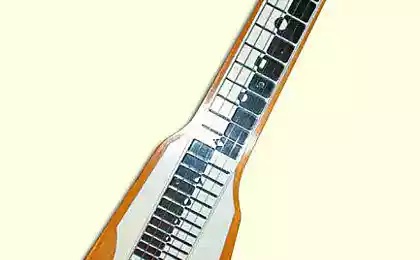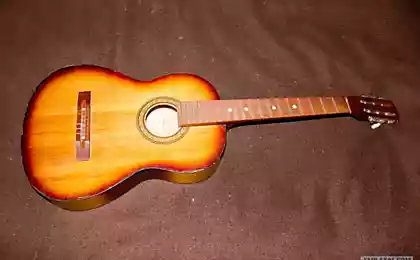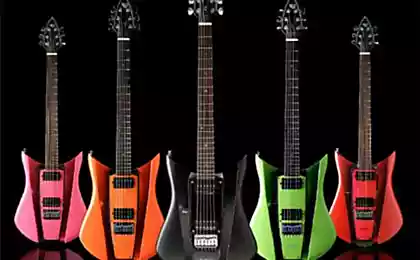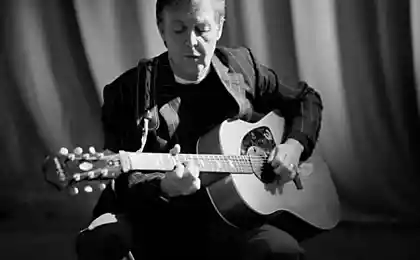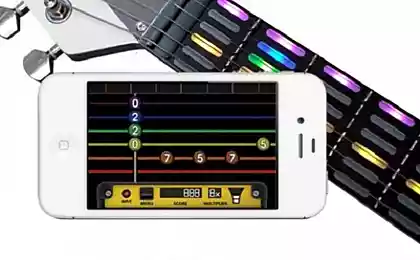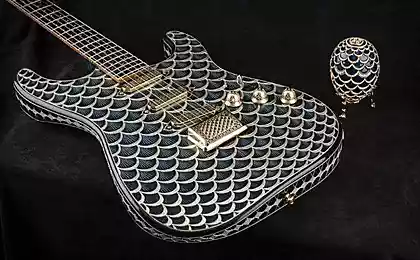1763
History of guitar
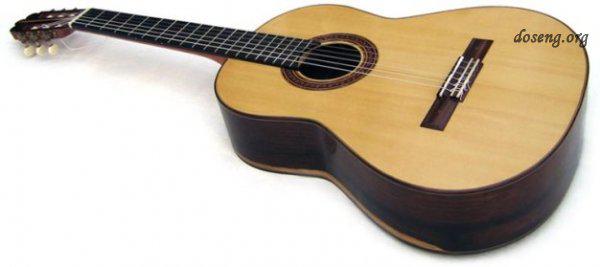
"Guitar - (App. Quitarra from the Greek. Kithara - lira) kind of stringed musical instrument with wooden body - cavity in the form of eights and a long-necked" - That is the information we can find, referring to the competent musicological publications and dictionaries. But, as is actually happening the birth and formation of this truly legendary instrument?
Many historians differently describe the history of the origin of the modern guitar and its varieties. It is not surprising, because the first string plucked instruments, which were the prototype of this guitar, there were in ancient times, 3-4 thousand years BC.
Stringed instruments fitted with a neck, appeared in ancient times. They make up the lute family in the broadest sense. The earliest surviving evidence - a Mesopotamian sculptures that relate to about 2 millennium BC. e. They sealed instruments with a small body, which was made from tortoiseshell or pumpkin (covered with, in all probability, the skin). Such tools exist to this day in some countries: in the Balkans - tamburitsa, Iran - sitar, Turkey - saz, Greece - bazooka. In Central Asia and northern India, there are also two-stringed dutar (used these days in Iran, Uzbekistan, Tajikistan, Turkmenistan). He rounded down and truncated in the upper part of the body and a long neck, which are screwed pegs. The decisive moment in the history of the instrument - the emergence of a new resonator body, consisting now of three parts: deck, upper deck and two shells that connect them. This stage occurs in China in 3 or 4 century BC. e. With the advent of tools yuan (nowadays neupotreblinemogo) and Yukina, the upper deck is made of solid wood plate. Since that time, tools, similar to a guitar, widely distributed in the Middle East. A beautiful example of one such tool is embodied in the frieze Ertama Buddhist monastery near Termez (Uzbekistan), a fragment of which is kept in St. Petersburg Hermitage. However, there is still no precise dating of the frieze: it can be attributed to the period between the 1st century BC. e. And the 3rd century BC. e. In ancient China, it is widely used various kinds of lute with a long neck. Particularly attracted the attention of the so-called Nefer (which means "beauty"). This tool, with its almond-shaped elongated body, can be considered one of the forerunners of our guitars. Lack of reliable data and fragmentation hinders the scientific study of history of the guitar. Most of all, we tend to think that she was born in the Middle East, and from there spread throughout Asia and Europe. Important role in this process belongs to Egypt. According to K. Omo, "starting from the 9th century to the west of the country to the European lute called Kitaro"; In addition, the obvious affinity between Nefer and the first tool shown in the Spanish manuscripts. The invasion of the Arabs could serve - this applies to the lute - factor in the relationship between North Africa and Southern Europe; but we can not exclude a certain influence in Asia Minor - in the Greco-Roman world.

As in antiquity and in medieval Europe, the emergence of tools - immediate predecessors of the guitar and their further evolution in the first centuries of the Christian era, it is impossible to trace because of the lack of reliable data. According to some researchers, the earliest image of such an instrument is to the II century. This is a bas-relief, which is decorated with tombstones in Merida (Spain). One can discern only the upper part of the tool. The design is such that it is acceptable, and later dating. In fact, advanced design tools as we once again find only twelve centuries later.
Much more archaic sound presented in the Utrecht Psalter (c. 820-830) "sitar with the stamp," despite the obvious desire of the artist-miniaturist to the ornamental pomp of the image. The famous Stuttgart Psalter, made a few decades later, probably in France, in the scriptorium of the abbey of Saint-Germain-des-Prés (c. 830-860), it contains extremely interesting to our study miniatures. They can see ten beautiful tools that have specifically named guitars. This suggests that the structure of the guitar in those days takes its main features. Resonator body, neck and Pegs box are made as separate parts; string (three to six) are attached to the circular projection, which is placed at the lower edge of the housing. Artist leads them to oscillate with a long plectrum.
The Latin word cithara comes from the Greek word cittern and long before the Middle Ages used to refer to species guitar as kitaire, quitaire, quitarre, entered into use after 1250.
Unfortunately, this precious document is an isolated case. The closest to it in time images of instruments - guitar predecessors, we find only in X - XI centuries in Spain. The design looks like they are not as developed.
Spain. Especially noteworthy are a number of manuscripts that are a common source of origin. Based on the manuscript of the Asturian monk Beatus Liebana (VIII) «Commentaires de l'Apocalypse», containing a collection of different interpretations of the Apocalypse. The value of the manuscript has been so great that it came to light numerous copies of it, decorated with miniatures. By tradition, they depict musicians. In most cases, the artists are content with repeating the already known images, but some masters seek to capture tools, which play their contemporaries. With this fails to detect various types of building tools corresponding to different eras and regions.
Since the image of the X century stringed plucked instruments became common. We can reveal the formation and propagation of a particular type of instrument, concise and distribution of a particular type of instrument, laconic in its design, the overall appearance and the way the game resembles the Egyptian nefer. Its characteristics indicate the initial stage of development: string (three or four) are attached to a semi-circular base placed at the bottom of the deck and stretched by a bulky pins inserted in Kolkova box.
These iconographic monuments indicate that the instruments of the period still combines the traits that in the Renaissance "distributed" between the various types of plucked - such as the viola, vihuela and guitar.
Since the middle of the XIII century information about the evolution of the guitar on its properties, on the role of her musical life become more accurate.
Complement each other two sources: "The Book of Good Love" Juan Ruiz, Archpriest of Hita and "Cantiga St. Mary" (c. 1250) - a collection of hymns in honor of the Virgin Mary - decorated thumbnail manuscript, in which the artist depicted the court minstrels with guitars.
At that time there were already two types of guitars - Guitar Moorish and Latin guitar.
Moorish guitar - oval, and played it mostly plectrum (mediator), which gives the sharpness of her tone, to complain that his contemporaries. Moorish guitar pictured in the book "Cantiga" very beautiful in form and structure. This guitar is not widely spread among the village musicians and attracted royals and falls to the court of Alfonso X.
Latin guitar has a more complex form, and due to its soft sound it is becoming popular among the lovers of exquisite music. Apparently, the tool was highly appreciated by the royal court, as is found in only three miniatures, and only in the hands of minstrels. Design features and sound say that the Latin guitar was closer forerunner of the modern classical guitar.
When you play the Latin or Roman cithara used technique punteado, ie the game pinch. And when you play the Moorish or Arabic cittern - reception rasgeado, ie "saber" on the strings all the fingers of his right hand. Later the game pinch - punteado became the basis of the classical school. This added the nail and finger techniques of sound for the right hand, the game with the support - apoiando and without the support - tirando on the string when plucked.

In the XVI century, the most common instrument was the vihuela (vihuela).
Upon receiving the game and appearance close to the vihuela guitar, but it has a narrow and convex hull.
Since the XVI to XVII century the most widespread in Spain, received a kind of vihuela - vihuela de mano (vihuela de mano) - hand vihuela.
Vihuela de mano was common in the higher strata of Spanish society. Tools richly decorated with inlaid hardwood, bone and silver.
They accompanied the singing, playing solo and duet, played variations, fantasies, dances, plays. The most significant artists and writers of pieces for vihuela were Luis Milan, Diego de narwhal.
At the end of the XVI century vihuela lost its former importance, however, it was used until the end of the XVII century.
The earliest publication of works for guitar appeared in Spain in the middle of the XVI century. Composers are not too highly of the expressive possibilities of the instrument, and the first steps were modest: Four fancy one, and Pavan one galliard included composer Mudarra Alonso in his "Three music compilations" for vihuela (Seville, 1546).
In the second half of the XVI century guitar music in Spain came to a brilliant flowering.
It began to get more and more folk tunes. Gradually it became a tradition to compose variations to popular works. These variations are called "diferensias» (diferencias). They feel the love of the Spaniards to the jewelry, the number of music "ornament", these variations can be compared with arabesques of the Alhambra.
Ingenuity composers was just inexhaustible. For example, Enriquez de Valderrabano on the subject of the popular satirical romance «Conde claros» wrote the play of one hundred and twenty variations.
At the turn of the XV - XVI centuries, the time of entry into other European countries had five guitar strings and quart system, as well as its sister the lute. In Germany and Italy, it has been added to the sixth string and guitar acquired its classic look, slightly changing the system for better sound use of open strings. As such, the guitar has become a serious musical instrument with broad capabilities.
This time we will consider the starting point of the history of the modern guitar. At that time already existed in parallel with the Spanish classical guitar and its other varieties, based on the geographic location and characteristics of cultural development.
English guitar in England and America of the 18th century pear-shaped instrument called a 6 - 14 strings (a more accurate name - cittern).
At the end of the XVI century, the number of strings of the guitar, modeled on the lute, increases in the last two decades of the XVI century in Europe, including Spain, began to spread the guitar with five rows. It will apply until the end of the XVIII century.
In the first half of the XVII century, with the emergence of a guitar with five rows of the nature of guitar music is changing. In Europe, it spreads rasgeado style borrowed from the Spaniards.
This change is not all came to mind, for example, the French theorist of Bordeaux Pierre Trichet noted with regret that the guitar is now only serves to musical accompaniment dancers who dance, "twitching all over, ridiculous and funny gesticulating, so the game is on the instrument becomes unclear and inconsistent. »
In the second half of the XVII century Spanish art in the guitar again, a period of prosperity. Guitar prefer other tools, updated style of composing. In many ways it was the merit of Spanish composer Gaspar Sanz.
By the middle of the XVIII century in the history of the classical guitar in Europe there is a crisis. In Spain, the crisis was due to the general decline of culture in the country.
Until the 1770s guitar retains the characteristics acquired at the beginning of the XVII century. The guitar is equipped with nine strings that make up the five rows. The two lowest strings are tuned in octaves.
Over the next thirty years, the European masters are gradually changing tool. Story becomes fixed and introduced the use of single strings. This greatly impoverishes Register instrument and to make the sound more full, some masters are starting to add a sixth bass string "Mi" The result is a system that has been preserved to our time. Spain, unlike other European countries, did not immediately accept these innovations. There master in his own usovershenstvyvayut guitar, creating instruments with six double strings, but further distinctive Spanish course will join the mainstream European tradition. Written for the instrument with six single strings, the treatise Dionisio Aguado "School of Guitar" (Madrid, 1825) marks the final departure from the principle of designing guitars with six double strings.
Because of addiction to the traditional instrument, Spain returns to the first professional music for the guitar. In the second half of the XVIII century, the guitar is once again becoming a fashionable tool.
Further development of the guitar in Spain and Europe is due to the composer and guitarist Fernando Sora.
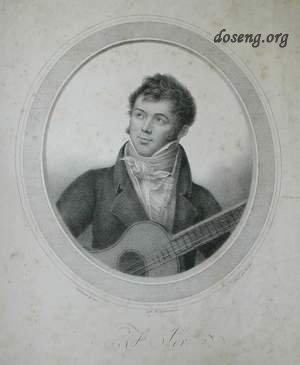
He was nicknamed "Beethoven guitar," his deep and emotional music, soft, velvety sonority of his play made him one of the greatest guitarists of his time.
Sor was born in Barcelona. At the age of five he was composing songs, accompanying himself on his father's old guitar. He received his musical education in a Catholic monastery of Montserrat near Barcelona, and at age 13 he was already composing complex music.
Once the teacher ordered him to compose a solemn Mass for soloists, choir and organ, but due to illness he was unable to prepare it for deadline. Sor helped his teacher, for one night brilliantly execute the order.
After finishing his musical education and finding a patron, Sor settled in Madrid and devoted himself entirely to composing music and improve your guitar skills. In 1813 he went to Paris, where he soon gained a reputation as one of the best virtuosos of captivity his playing Berlioz, Cherubini and others who lived in the French capital musicians. In 1815 Sor sent to London, where he produces a true sensation with his play on the guitar. In 1823 Sor already in Russia, where it also has an extremely welcome. During one of his visits to St. Petersburg Soar was invited to the court of Empress Elizabeth Alexeevna, the wife of Alexander I, which showed great favor to the guitarist. The proximity to the court of Sora promised a bright future, and he intended to stay in Russia forever, but was forced to leave her after the death of the empress.
After returning to Western Europe, Sor continued to enjoy great success. His prestige among guitarists was extremely high. However, by the 30th of the XIX century the guitar ceases to be a fashionable instrument, and Soar, as a guitarist and as a composer, also goes out of fashion. In June 1839 Sor died, half-forgotten even his friends musicians.
Music Sora became a part of history, many of his guitar works continue to live on the concert stage, and his "School for the guitar" (1830) is estimated by many as the most outstanding work devoted to guitar performance techniques.
Another great guitarist at the time was a contemporary and friend of Sora Dionisio Aguado.
He became famous not only as a virtuoso guitarist, but also as a talented teacher. Unlike the soft and velvety execution of Sora, the style of play is different Aguado light, bright and brilliant sound. Aguado was born in Madrid. Among his teachers of music known as the famous Spanish guitarist Padre Basilio. After the death of his father in 1803 Aguado went to the estate, near Aranjuez, where persistently engaged in guitar and achieved virtuosity.
However, unlike Sora, success came to him not so fast, and until 1824, his name did not attract much attention. From 1825 he lived in Paris Aguado and concerts in Europe, at the same time doing the education of students. In the same year it was published his school «Metodo de guitarra». Returning in 1838 to Spain and settled in Madrid, Aguado until the end of his life continues to teach. His musical legacy includes dozens of sketches, variations, fantasies, rondo, which reflect its experimental search and innovative techniques of playing the guitar.
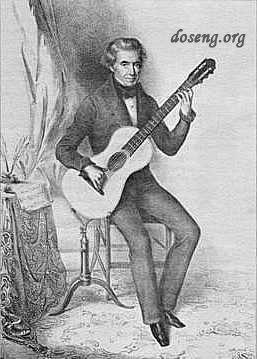
Beginning of the XIX century. The whole of Europe is covered by "gitaromaniey." Fans admire her, virtuoso touring across Europe with concerts, triggering enthusiastic audience applause.
